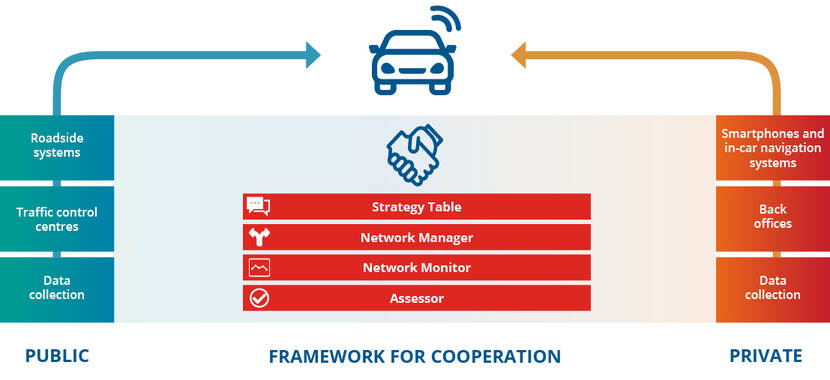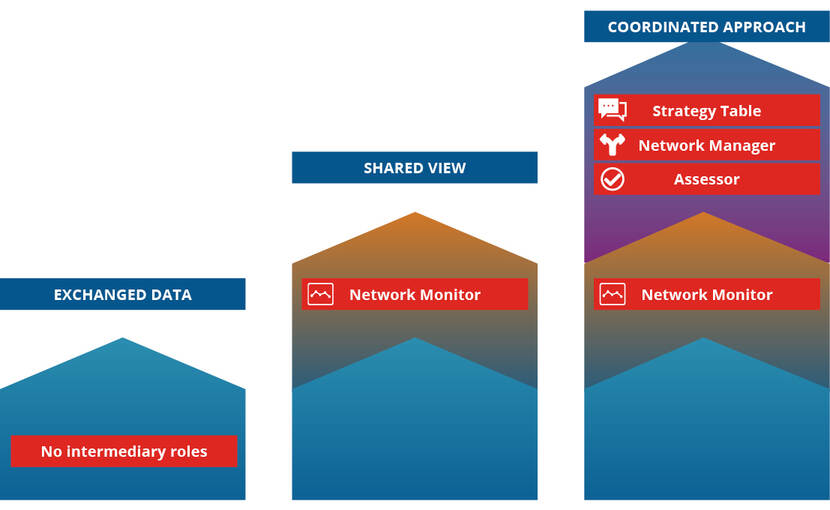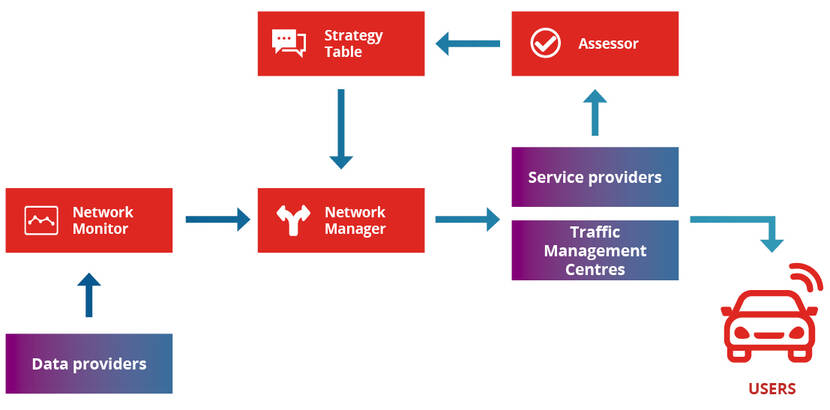Cooperation framework

The SOCRATES2.0 partners created a cooperation framework to defining three ways of working together. We call this the cooperation models. To make the public–private cooperation work, we introduced four intermediary roles. The main distinction between the cooperation models is the level of communality, which determines how close partners work together. In other words, partners can choose to just ‘wave’, ‘shake hands’ or ‘hug’ each other.

The Exchanged Data cooperation model
This cooperation model is about exchanging data on a voluntary basis, using an agreed standard protocol. There are multiple European standards and variations available for the similar purposes. It is a challenge to agree on one standard and use it in the same aligned way.
The main focus is exchanging information with the aim of obtaining maximum information coverage for the end users.
The Shared View cooperation model
This cooperation model introduces the concept of ‘shared view’. The ‘shared view’ is a common situational or operational picture with a ground truth. This means that all involved parties, public and private, contribute to and can operate on the same consolidated information.
The Network Monitor is introduced here as a new intermediary role. Each party can choose to use the shared view and use it in its own services to communicate with the end user.

The Coordinated Approach cooperation model
In the Coordinated Approach, the partners identify common problems and develop solutions based on coordinated actions from all parties involved to achieve a set of agreed common goals.
The Strategy Table, the Network Manager and the Assessor are additionally introduced here as new intermediary roles. The challenge is to align public and private goals towards common goals and jointly develop coordinated services to achieve these goals. A reward system can be part of the Coordinated Approach to stimulate contribution from the parties involved including travellers.

New intermediary roles
The main new building blocks for the cooperation models are the intermediary roles. A role is defined as a set of tasks that need to be carried out together to create added value for the cooperation. The application of the SOCRATES2.0 framework is flexible and adaptable to suit regional situations.
Four new intermediary roles were created to enable a public-private cooperation:
Video: SOCRATES2.0 Animation on the Intermediary Roles
[Openingsscreen: Interactive Traffic Management. A close cooperation between pubic and private partners ]
The interests of road users together as a group can be different from the interests of an individual road user.
There is for instance a collective interest to make traffic safer, more sustainable and more accessible.
However, an individual's personal interest may be to reach their destination as quickly as possible by the fastest route.
But, if everyone does that, there will no longer be a fastest route and everyone will end up taking longer to reach their destination, undermining the collective interests.
That's why we started Project Socrates.
This Framework supports data exchange between different partners, helps enrich data for creating a shared view and coordinates actions of traffic management centres and service providers.
The Network Monitor and Network Manager are new intermediary roles introduced by Socrates.
In the Network Monitor data is collected and datasets are completed. The data is then distributed.
The Network Manager detects any problems, devises solutions, and requests traffic centres and service providers to activate certain services.
For example, to avoid a particular route because a traffic jam is expected or to prevent a traffic jam from occurring in the first place.
The service providers translate the Network Manager's general service request into concrete route advice for the user.
Traffic management centres also translate the information into alternative routes to avoid the problem.
Two other roles introduced by Socrates are the Assessor and the Strategy Table.
The Assessor ensures performance monitoring and the neutral assessment of the impact.
The Strategy Table determines the KPI's of the cooperation.
By bringing together public-private goals, taking joint action, and developing a common language, sustainable cooperation can emerge so that the road user and community is best served.
So, get started now with the Socrates framework!
For more information, check the Socrates magazine.
[Ending screen: SOCRATES2.0 www.socrates2.org]
Network Monitor
The Network Monitor is especially useful if multiple data providers participate and a shared view is of added value to service providers and TMC’s. To this end, the Network Monitor collects data from road authorities and private data providers and determines the shared view for the agreed network. In this process, the Network Monitor can perform data handling tasks such as quality assessment, data completion and fusion of different public-private sources according to use case and business requirements. Furthermore, the Network Monitor distributes the shared view (e.g. actual volume and speed data) to other intermediary roles and agreed parties. Partners can then base their own services on a higher quality shared view.
Strategy Table
The Strategy Table develops agreed common goals based on the individual interests of participating parties. The balance between common and individual goals is essential for sustainable cooperation. Strategic KPIs are derived from the common goals to steer the Network Manager. Based on Assessor reports, the Strategy Table monitors the performance of the cooperation and can make adjustments if needed. Partners agree on what services they can deploy and make them available in the so-called Toolbox for the Network Manager.
Network Manager
The Network Manager uses the common situational picture from the Network Monitor and the KPIs from the Strategy Table to determine inefficiencies or problem states on the network. Based on this insight, the Network Manager uses algorithms to select available services (from the Toolbox) that can solve or alleviate the situation. Then, the Network Manager sends out coordinated service requests to all service providers and TMCs to help alleviate the problem. Service providers and TMCs are responsible to carry out the solution (e.g. through individual routing and roadside equipment settings).
Assessor
The Assessor supports the Coordinated Approach by providing the Strategy Table (and the Network Manager) with insights on the service performance based on data and information individually collected by all partners involved in delivering the service. The Assessor translates them into the predefined goals and KPIs. The partners seated at the Strategy Table use the validated insights from the Assessor for data-driven strategic decisions on how to improve the jointly developed services.
Read all the papers on the SOCRATES2.0 Cooperation Framework
- The role of the Network Monitor in the SOCRATES2.0 project (PDF)
- The role of the Network Manager in the SOCRATES2.0 project (PDF)
- Proactive Network Management in the SOCRATES 2.0 project (PDF)
- The role of the Assessor in the SOCRATES2.0 project (PDF)
- The role of the Strategy Table in in the SOCRATES2.0 project (PDF)













